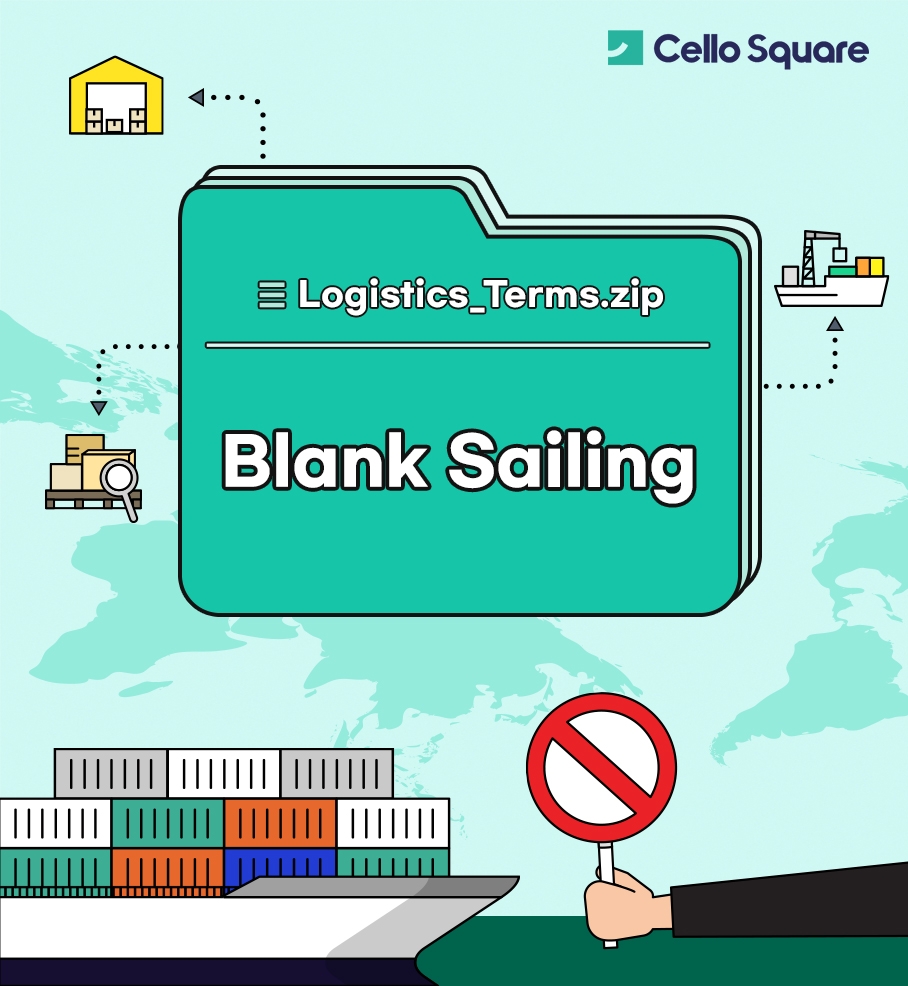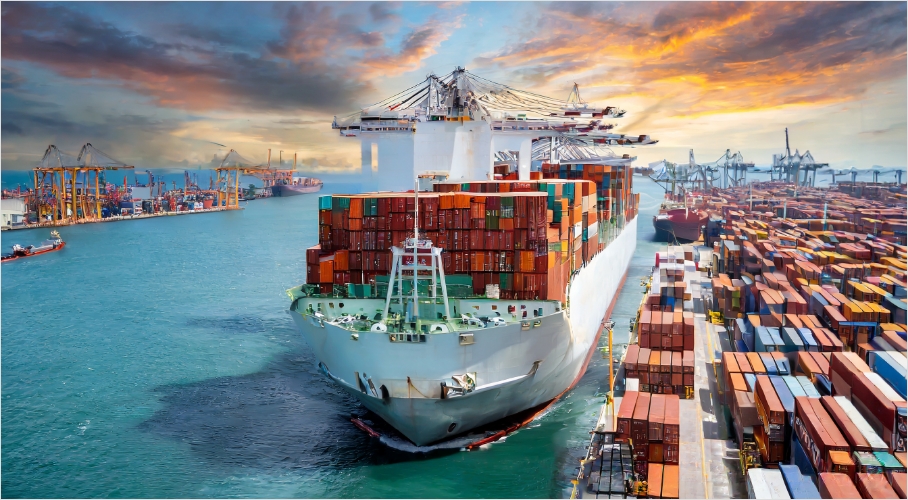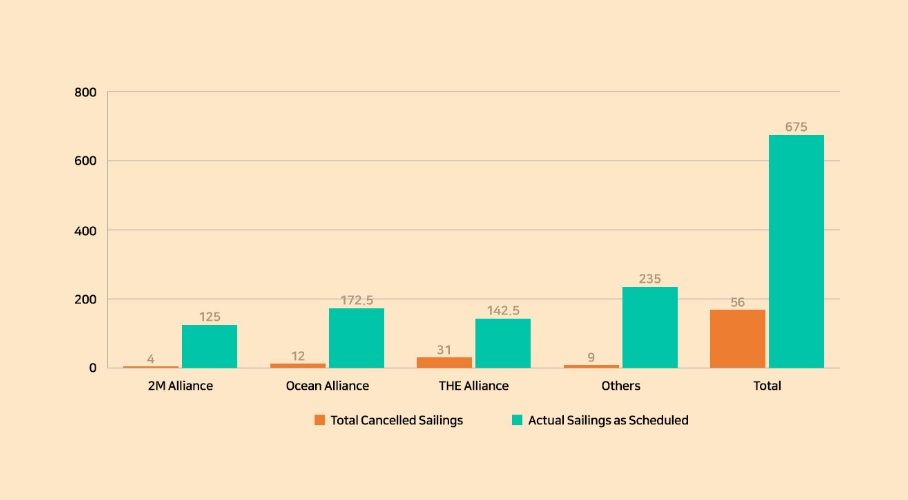


A blank sailing is when a shipping line or carrier skips a particular port or cancels an entire voyage. The idea behind blank sailing is to balance supply and demand in uncertain market conditions by suspending certain services or operations. When cargo volumes decline due to economic factors, carriers may cancel some sailings to reduce operating costs. Blank sailings also reduce supply, creating a temporary supply-demand balance to stabilize or increase freight rates.
The key aspect of blank sailing is that it is a deliberate and strategic decision made by shipping lines or carriers. This isn't about unforeseen circumstances like weather or accidents, but a planned move. Blank sailing can manifest in two primary ways:
1. Skipping Port Calls
A carrier might choose to bypass an intermediate stop, like sailing directly from Shanghai to Rotterdam and skipping a usual stop in between. This decision could be influenced by various factors like reducing transit time or avoiding congested ports.
2. Canceling Entire Services
In more significant cases, a carrier might suspend an entire service loop, such as stopping all shipments between Asia and the US West Coast for a period. This could be due to reasons like balancing supply and demand, managing fleet deployment, or economic considerations. (Source : Firefly, Adobe)
(Source : Firefly, Adobe)

Ocean carriers utilize blank sailings for a few key reasons:
1. Lowering Operating Costs When Volumes Are Down
When there's a decrease in cargo volumes, operating a full-service route can be financially draining for carriers. By cancelling voyages (blank sailings), they avoid the costs associated with transporting a below-capacity load, such as fuel, port charges, and crew expenses.
2. Tightening Supply and Stabilizing Freight Rates
In the shipping industry, the balance between supply and demand directly affects freight rates. By reducing the number of voyages, carriers can tighten the available capacity, preventing an oversupply situation. This helps in stabilizing or even potentially increasing freight rates, ensuring that they don't plummet due to an excess of shipping space.
3. Aligning Vessel Capacity with Fluctuating Demand
Demand for shipping can be highly variable, influenced by factors like seasonal changes, economic shifts, and global trade dynamics. Blank sailings allow carriers to quickly adjust their capacity to match current demand levels, ensuring more efficient use of their vessels.
4. Managing Overcapacity and Vessel Utilization
Overcapacity is a significant issue in the shipping industry, where too many ships are available compared to the demand for shipping services. By employing blank sailings, carriers can better manage their fleet, ensuring that each operating vessel carries a load closer to its full capacity, thus improving overall vessel utilization.
5. Maintaining Freight Rates and Revenue in Soft Markets
In softer market conditions, where demand is low, maintaining profitability becomes a challenge for carriers. Blank sailings are a strategic response to such situations, helping to maintain freight rates at a sustainable level by controlling the available capacity, thus protecting revenue. (Source : Firefly, Adobe)
(Source : Firefly, Adobe)

A recent analysis by Drewry, a British shipping consultant, vividly demonstrates the current market trends and how ocean carriers are strategically adapting to these changes.[1]
1. High Frequency of Blank Sailings
The cancellation of 56 out of 675 scheduled sailings between weeks 11 and 15 on key routes is a significant number. About 8.3% of cancellations are quite high, and it reflects the carriers' active response to the changing market conditions. This high frequency of blank sailings illustrates how carriers are strategically adjusting their operations.
2. Alliance-Specific Responses
THE Alliance (cancellation rate 21.8%): With 31 sailings out of a total of 142.5 were cancelled, THE Alliance seems to be taking a more aggressive approach to managing its capacity and aligning it with current demand.
OCEAN Alliance(cancellation rate 7.0%): With 12 sailings out of a total of 172.5 were cancelled, the OCEAN Alliance is also engaging in capacity management, though to a lesser extent compared to THE Alliance.
2M Alliance(cancellation rate 3.2%) and Non-Alliance Carriers(cancellation rate 3.8%): The four cancellations by 2M Alliance and nine by non-alliance carriers indicate that this strategy is widespread across different groups in the industry, albeit at varying degrees.
3. Route-Specific Trends
Trans-Pacific Route: The cancellation of 57% of scheduled sailings on this route is particularly striking. This significant reduction nearly halves the transportation services on one of the most crucial trade lanes, underscoring the impact of current market dynamics.
Asia-North Europe and Mediterranean Routes: With 34% blank sailings, these routes also show substantial cancellations, reflecting similar strategic responses to demand fluctuations.
Transatlantic Westbound: The relatively lower 9% cancellation rate here might indicate more stable demand or different strategic priorities on this route.
[Scheduled Sailings vs Canceled Sailings] (Source: Drewry[1])
(Source: Drewry[1]) The blank sailing data reveals how swiftly and adaptively carriers are responding to market conditions. This agility is crucial in an industry where demand can be volatile and unpredictable. For businesses relying on these shipping services, this information is vital for planning and forecasting. Understanding the likelihood of blank sailings can help them develop more resilient supply chains and logistics strategies.


Blank sailing, while a practical tool for managing immediate supply and demand imbalances in the shipping industry, does come with its set of drawbacks and challenges, especially when considered as a long-term strategy.
1. Customer Dissatisfaction from Service Disruptions
Impact on Shippers: When voyages are canceled, it directly affects shippers who rely on these services for transporting their goods. This can lead to logistical challenges and delays in their supply chain.
Harm to Customer Relations: Regular or excessive use of blank sailing can strain relationships with customers. Businesses value reliability and predictability in shipping schedules, and frequent cancellations can lead to a loss of trust in the carrier's services.
2. Lack of Long-Term Perspective
Tactical vs. Strategic: Blank sailing is more of a reactive, tactical measure to address immediate market conditions. It lacks the foresight and planning that come with long-term strategic approaches, which are based on thorough market analysis and forecasting.
Potential Dependence on Short-Term Fixes: Over-reliance on blank sailing can lead carriers to focus less on developing robust, long-term strategies that are more sustainable and beneficial in the long run.
3. Risk of Overcorrection
Capacity and Rate Fluctuations: An aggressive blank sailing policy might lead to an overcorrection. This means that when the market demand picks up unexpectedly, the industry might find itself with too tight a capacity, leading to sudden spikes in freight rates.
Market Volatility: Such fluctuations can contribute to market volatility, making it difficult for shippers and carriers to plan effectively and budget their logistics costs.
While blank sailing can be an effective short-term solution for balancing supply and demand in the shipping industry, its limitations and potential negative impacts, particularly in terms of customer satisfaction and strategic planning, make it a less ideal approach for long-term operational stability. This underscores the need for carriers to balance immediate tactical decisions with a more comprehensive, forward-looking strategy.
-
In summary, blank sailing is an important tool for ocean carriers to defend freight rates during industry downturns. When used judiciously, it can help carriers weather periods of reduced demand. However, carriers must balance economic benefits against customer service impacts when blanking voyages. With the potential for an economic slowdown in near future, blank sailings are likely to remain an essential strategy for ocean carriers looking to maintain profitability if trade volumes weaken. Carriers will continue using blank sailings dynamically to match supply and demand in an uncertain market.